What’s in a Label?
How to Decipher Grocery Terms
The number of health claims on food packaging continues to grow. It’s no longer just the nutrition label that matters. From “all natural” to “cage free” and “pasture raised,” food claims can be confusing and even misleading. Here’s how to read those labels and fully understand what you’re buying – and eating.
Who’s in Charge?
There are two government agencies responsible for food labeling in the U.S.: the Food and Drug Administration (FDA) and the United States Department of Agriculture (USDA). The FDA is responsible for regulating most of the food we eat, including produce, most packaged foods, and eggs still in the shell. The USDA is responsible for all meat, poultry, and egg products.http://www.bidmc.org/CentersandDepartments/Departments/DigestiveDiseaseCenter/CeliacCenter/CeliacNow/NUTRAGFD/LBLRDNG/FDAUSDALBLLWS.aspx
Food Packaging Terms, from A to Z
Cage Free
Found on: Eggs, poultry
Eggs or poultry labeled “cage free” come from birds not confined to cages, with access to open space.http://www.gcbl.org/live/food/healthy-diet/what-do-food-labels-really-mean However, just because they have access to open space does not mean they can run free. Each bird is allotted an average of one square foot of space; the most common environment for these birds is within a large open barn or aviary.http://www.npr.org/sections/thesalt/2014/12/23/370377902/farm-fresh-natural-eggs-not-always-what-they-re-cracked-up-to-be These birds are not required to have access to the outdoors.
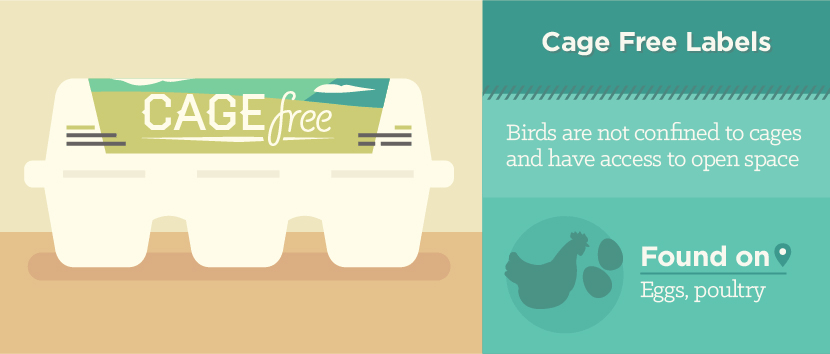
Free Range
Found on: Meat, poultry, eggs
Free-range eggs and poultry come from cage-free birds that also have free access to the outdoors.http://www.npr.org/sections/thesalt/2014/12/23/370377902/farm-fresh-natural-eggs-not-always-what-they-re-cracked-up-to-be That access is typically a few small doors on the wall of a giant warehouse or aviary that leads to a small screened-in area with a cement or dirt floor, so it’s not exactly the open pasture you may imagine.http://www.npr.org/sections/thesalt/2014/12/23/370377902/farm-fresh-natural-eggs-not-always-what-they-re-cracked-up-to-be While companies are allowed to label eggs “free range,” the USDA only regulates the term for poultry raised for its meat, not egg-laying hens or other animals.http://www.cuesa.org/article/getting-know-your-meat-labels

Gluten Free, Free of Gluten, No Gluten, or Without Gluten
Found on: Anything
Any food labeled “gluten free” must contain no more than 20 parts per million of gluten, the protein found in wheat, barley, and rye. Use of the “gluten-free” label and logo are voluntary. But if a company includes this label, it is fully responsible for adhering to the standard and must not use the label in a misleading manner.http://www.fda.gov/Food/GuidanceRegulation/GuidanceDocumentsRegulatoryInformation/Allergens/ucm367654.htm
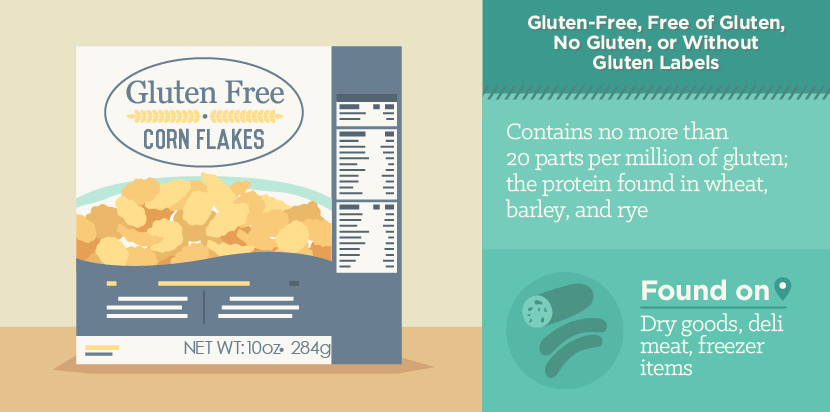
Grass Fed
Found on: Cattle, sheep, goats, bison
Grass-fed cows have been raised primarily in pastures, where they eat grasses, forbs (such as legumes and brassica-family vegetables), and cereal crops (before they produce grains), rather than on a feedlot where they would be fed corn or other grains.http://www.cuesa.org/article/getting-know-your-meat-labelshttp://www.gcbl.org/live/food/healthy-diet/what-do-food-labels-really-mean Grass-fed animals do not have to live on only grass for their entire lives – just for most of it.
The USDA’s definition of grass-fed still permits some confinement of the animals as long as they are also allowed to graze. However, the American Grassfed Association’s standards are more strict, stating that the animals must not be confined to a pen, feedlot, or any other area during the growing season and must have continuous access to open pasture during the season.http://www.cuesa.org/article/getting-know-your-meat-labels

Grass Finished
Found on: Meat from herd animals, primarily beef
While grass-fed animals may either start or end their lives eating grain on a feedlot, grass-finished meat comes from animals that have been raised on a forage diet consisting of grasses and other plants for their entire lives.http://www.beefboard.org/news/files/factsheets/grass-finished-beef.pdf
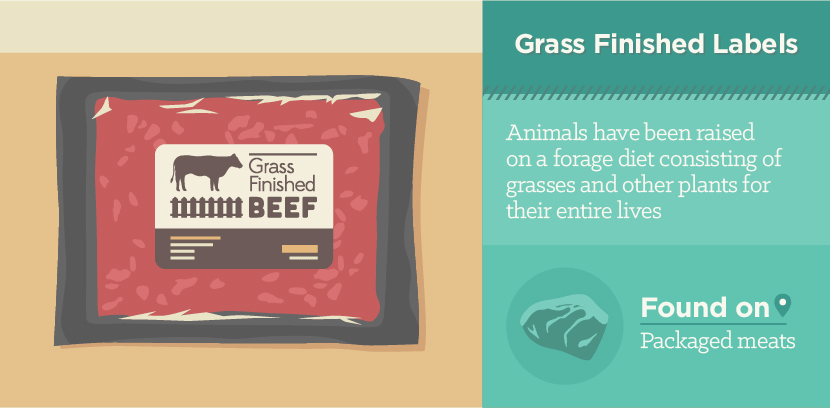
Light or Lite
Found on: Packaged foods
Foods labeled “light” or “lite” have fewer calories than their conventional counterparts.http://www.fda.gov/Food/GuidanceRegulation/GuidanceDocumentsRegulatoryInformation/LabelingNutrition/ucm064911.htm If 50 percent or more of the calories in the food item come from fat, the fat must be reduced by at least half, per reference amount customarily consumed (RACC) or a typical serving size of a certain food.http://www.fda.gov/Food/GuidanceRegulation/GuidanceDocumentsRegulatoryInformation/LabelingNutrition/ucm064911.htmhttp://www.accessdata.fda.gov/scripts/cdrh/cfdocs/cfcfr/cfrsearch.cfm?fr=101.12 If less than 50 percent of the calories in the food come from fat, it can mean the food has been changed to contain either one-third fewer calories or no more than half the fat of the regular version.http://www.fda.gov/Food/GuidanceRegulation/GuidanceDocumentsRegulatoryInformation/LabelingNutrition/ucm064911.htm
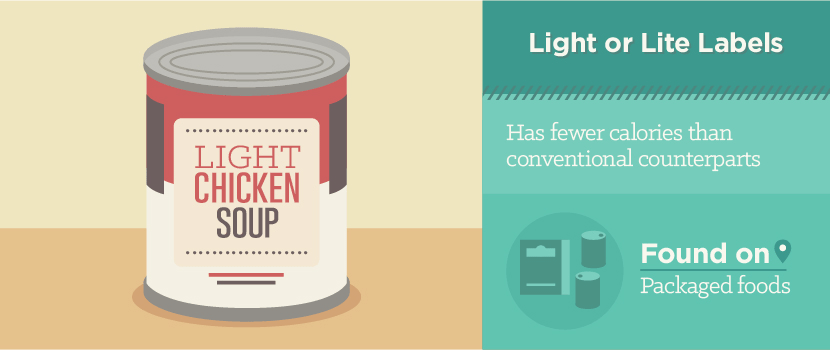
Local
Found on: Produce and animal products
While there is no legal definition of what “local” means in terms of food labeling, it’s a common word to see on food labels, and especially on produce in grocery stores and farmers’ markets. http://www.huffingtonpost.com/eve-turow/you-need-to-know-what-food-regulation_b_5596171.html Some grocers define “local” as food sourced from within 200 miles of a specific store, though others say 100 miles and others even say 400 miles. The best bet for understanding this label is to find out the specific town or area the item comes from, then take a peek at a map and judge for yourself.

Low Calorie
Found on: Processed/Packaged foods
The FDA defines “low calorie” as foods containing 40 calories or less per RACC.http://www.gpo.gov/fdsys/pkg/CFR-2013-title21-vol2/pdf/CFR-2013-title21-vol2-sec101-12.pdf Whole meals and main dishes labeled “low calorie” contain 120 calories or less per 100 grams of food.http://www.fda.gov/Food/GuidanceRegulation/GuidanceDocumentsRegulatoryInformation/LabelingNutrition/ucm064911.htm
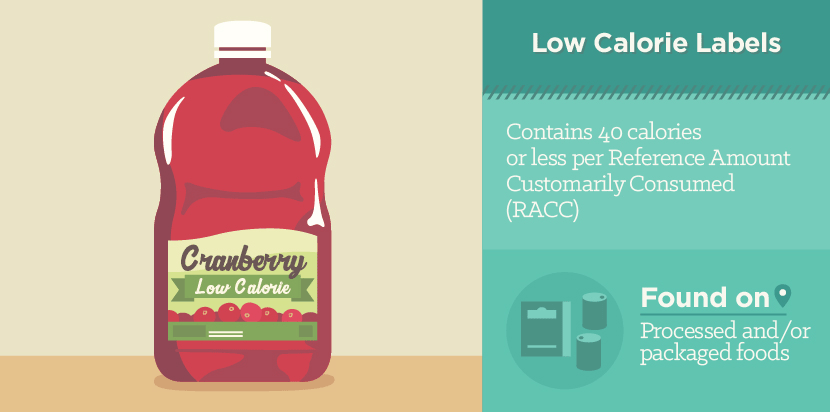
Low Cholesterol
Found on: Packaged foods
A food labeled “low cholesterol” must contain 20 milligrams or less of cholesterol per RACC, or per 50 grams of food if the RACC is small. Whole meals or main dishes labeled “low cholesterol” contain 20 milligrams of cholesterol or less per 100 grams of food.http://www.fda.gov/Food/GuidanceRegulation/GuidanceDocumentsRegulatoryInformation/LabelingNutrition/ucm064911.htm
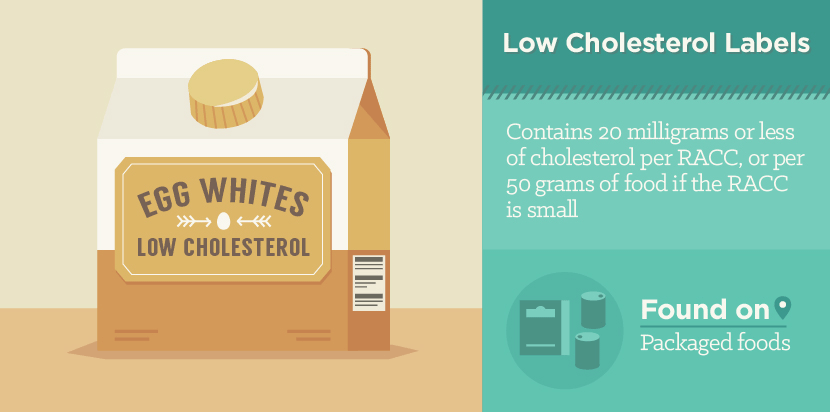
Low Fat
Found on: Packaged foods
Low fat foods contain less than 3 grams of fat per RACC, or per 50 grams of food if the RACC is small. Meals or main dishes labeled “low fat” must contain less than 3 grams of fat per 100 grams, and no more than 30 percent of the calories can come from fat.http://www.fda.gov/Food/GuidanceRegulation/GuidanceDocumentsRegulatoryInformation/LabelingNutrition/ucm064911.htm
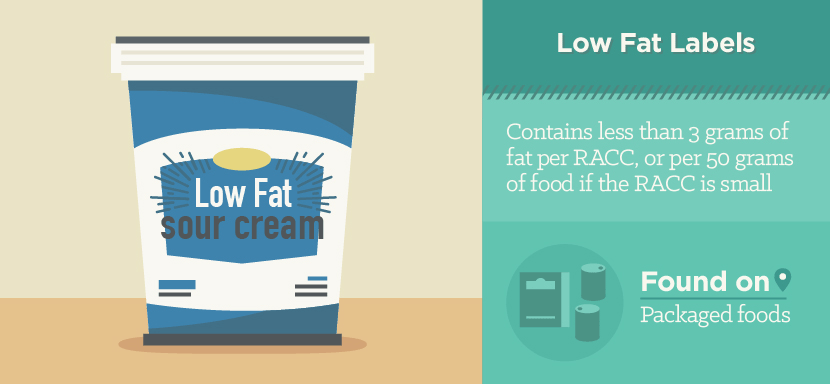
Multigrain
Found on: Packaged foods, bread, grain products
Multigrain products contain more than one type of grain. For example, whole-wheat bread is not considered multigrain because it only contains one type: wheat. Just because something is labeled “multigrain” does not necessarily mean it’s healthier, because the multiple grains may still be broken down and separated, meaning they are no longer whole grain.http://www.thekitchn.com/multigrain-whole-grain-whole-wheat-whats-the-difference-176886
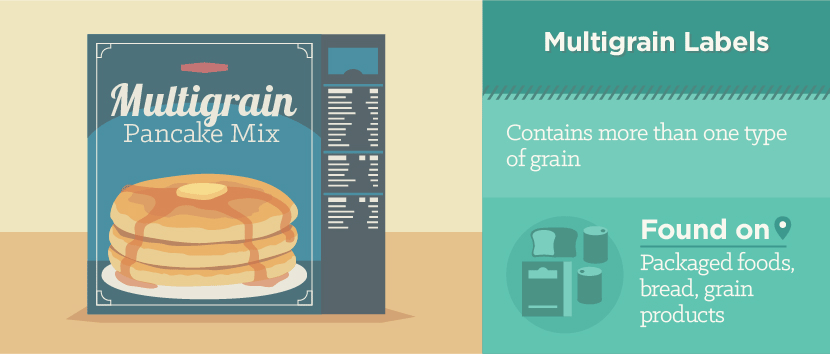
Natural, All Natural
Found on: Anything
While there’s no real government regulation of the term “natural” on food labels, the FDA does require foods with this label to contain no artificial colors, flavors, or synthetic ingredients.http://www.huffingtonpost.com/eve-turow/you-need-to-know-what-food-regulation_b_5596171.htmlhttp://www.thekitchn.com/5-grocery-store-labels-that-dont-actually-mean-much-220508http://www.huffingtonpost.com/eve-turow/you-need-to-know-what-food-regulation_b_5596171.html However, genetically modified foods and foods that contain antibiotics, growth hormones, or other chemicals are allowed to carry the label.http://www.gcbl.org/live/food/healthy-diet/what-do-food-labels-really-meanhttp://www.huffingtonpost.com/eve-turow/you-need-to-know-what-food-regulation_b_5596171.html
While one may seem better than the other, it’s important to realize that the government does not differentiate between the terms “natural” and “all natural” on food packaging.http://www.gcbl.org/live/food/healthy-diet/what-do-food-labels-really-mean
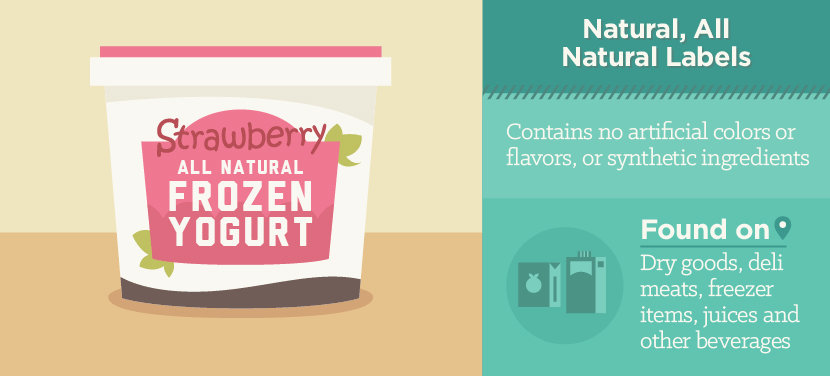
Organic and USDA Organic
Found on: Anything, including produce, animal products, and packaged foods
The “organic” claim is the most highly regulated term used on food packaging.http://www.huffingtonpost.com/eve-turow/you-need-to-know-what-food-regulation_b_5596171.htmlhttp://www.gcbl.org/live/food/healthy-diet/what-do-food-labels-really-mean Any food product with the “organic” label must consist of at least 95 percent organically produced ingredients. The other 5 percent must be on the list of approved ingredients published by the USDA. These products must also not use any antibiotics, growth hormones, pesticides, petroleum, sewage sludge-based fertilizers, bioengineering, or ionizing radiation at any point during their production.http://www.gcbl.org/live/food/healthy-diet/what-do-food-labels-really-mean
The rules get more specific, too. Organic farms are held to strict regulations. Organic produce must not use any synthetic pesticides, chemical fertilizers, or GMOs. A USDA-certified organic farm must not have had any prohibited substances (most notably pesticides) used on the land for three years prior to harvest for the produce to qualify as organic. Organic meat and dairy products cannot have ever been treated with growth hormones or antibiotics. In addition, organic livestock is required to have year-round access to a pasture to graze and must be fed non-GMO food.http://www.huffingtonpost.com/eve-turow/you-need-to-know-what-food-regulation_b_5596171.html Organic eggs must come from free-range, hormone- and antibiotic-free chickens raised only on organic feed.http://www.npr.org/sections/thesalt/2014/12/23/370377902/farm-fresh-natural-eggs-not-always-what-they-re-cracked-up-to-be
While many foods use the word “organic” on their labels, not all items include the coveted USDA Organic seal. There are two main reasons: first, it’s expensive to get the USDA to certify a farm and many small producers just can’t afford it or choose to put their funds elsewhere. Second, farms that produce organic goods not labeled by the USDA may not meet the three-year pesticide-free requirement quite yet, and therefore are not eligible for the USDA certification.http://www.huffingtonpost.com/eve-turow/you-need-to-know-what-food-regulation_b_5596171.html
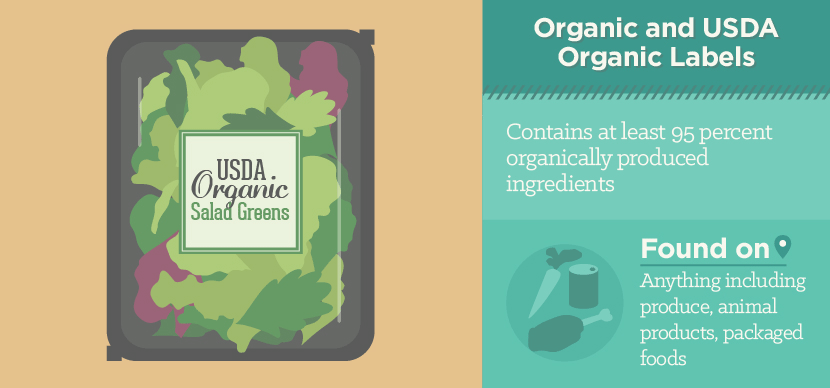
100 Percent Organic
Found on: Anything, namely animal products and packaged foods
Foods labeled “100 percent organic” contain only organic ingredients, unlike “organic” foods, which only have to contain 95 percent organic ingredients.http://www.gcbl.org/live/food/healthy-diet/what-do-food-labels-really-mean
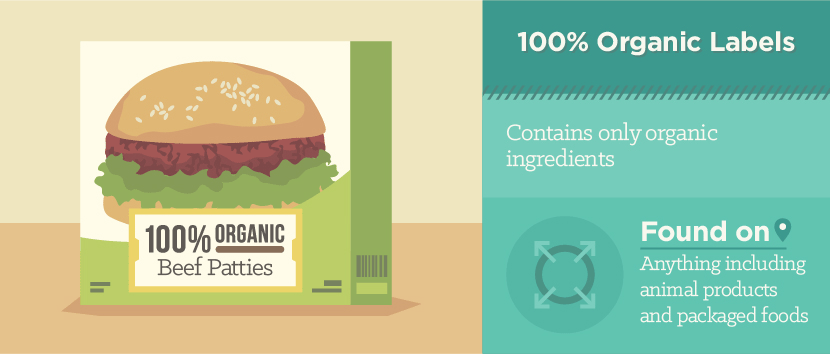
Made with Organic Ingredients
Found on: Packaged foods
Packaged foods containing at least 70 percent organic ingredients can be labeled “made with organic ingredients.” However, none of the ingredients – even the non-organic ones – can have been processed with sewage sludge-based fertilizers or ionizing radiation. While none of the main displays for these products can include the word “organic,” the displays can list up to three of the organic ingredients, and all of the organic ingredients should be identified in the ingredients list.http://www.gcbl.org/live/food/healthy-diet/what-do-food-labels-really-mean
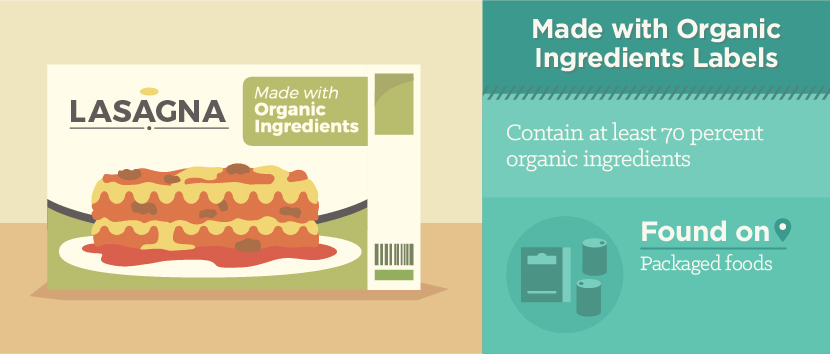
Pasture Raised or Pastured
Found on: Meat, eggs, poultry
The term “pasture raised” is not regulated by the USDA. But pasture raised or pastured is very similar to free range, except that pastured animals typically have more free access to open outdoor space.http://www.growandbehold.com/index.php?page=Glossary Pasture-raised birds could be considered the best type, since this method of raising best replicates poultry’s natural environment. These birds spend most of their lives outdoors, with a good amount of open outdoor space and access to a barn. In addition to corn feed (sometimes organic, sometimes not), these birds often enjoy a diet of worms, insects, and grass.http://www.npr.org/sections/thesalt/2014/12/23/370377902/farm-fresh-natural-eggs-not-always-what-they-re-cracked-up-to-be Pastured cattle are raised outdoors in a pasture, where the animals are allowed to roam and feed on the grass. Pastured animals may be fed a small amount of grain to supplement their grass-based diet, especially in the winter (unless it is for pastured, grass-finished meat).http://www.growandbehold.com/index.php?page=Glossary
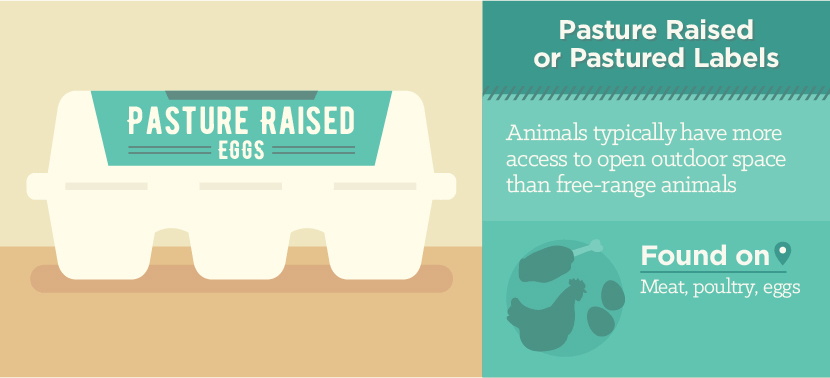
Raised Without Antibiotics
Found on: Dairy products, animal products
If an animal is given antibiotics for any reason over the course of its life, its meat, eggs, or milk may not be labeled “organic” or “free of antibiotics.”http://www.foodandwaterwatch.org/food/consumer-labels/labels-that-tell-you-a-little/
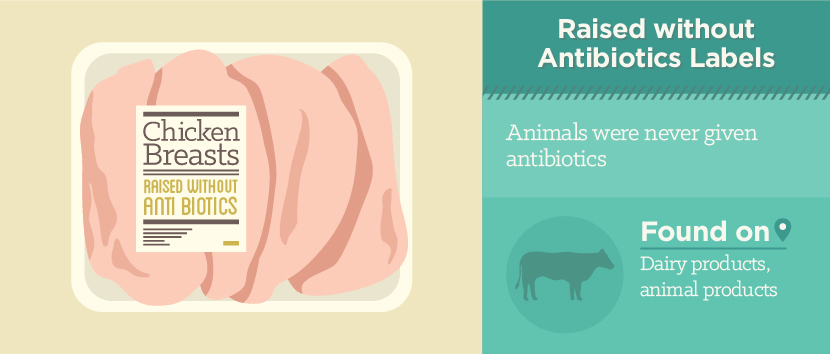
Raised Without Added Hormones or Not Treated with Hormones
Found on: Dairy products, beef
While it’s illegal to use hormones in pig or poultry production, the USDA does permit producers to give beef and dairy cattle hormones, most commonly recombinant bovine growth hormone (aka rBGH or rBST), which is often used to increase milk production. Any beef or dairy product with this label comes from an animal that was never given synthetic hormones.http://www.foodandwaterwatch.org/food/consumer-labels/labels-that-tell-you-a-little/
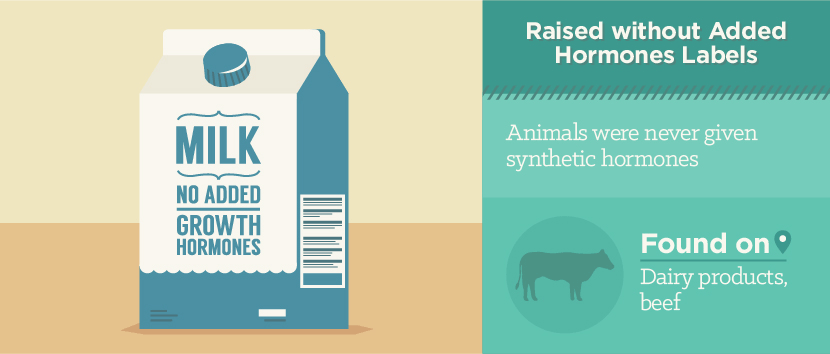
Vegetarian Fed
Found on: Eggs, chickens, pork
In the wild, hens eat worms and insects in addition to grass and seeds. The poultry and eggs labeled “vegetarian fed” in the grocery store come from birds that consumed an entirely vegetarian diet. Specifically, the hens that produce eggs labeled “vegetarian fed” likely ate a diet of corn fortified with amino acids. There is no proven health benefit to eating eggs produced by vegetarian-fed hens.http://www.npr.org/sections/thesalt/2014/12/23/370377902/farm-fresh-natural-eggs-not-always-what-they-re-cracked-up-to-be
The “vegetarian-fed” label can also appear on pork products such as bacon or cuts of meat from animals that have been raised on an entirely vegetarian diet.
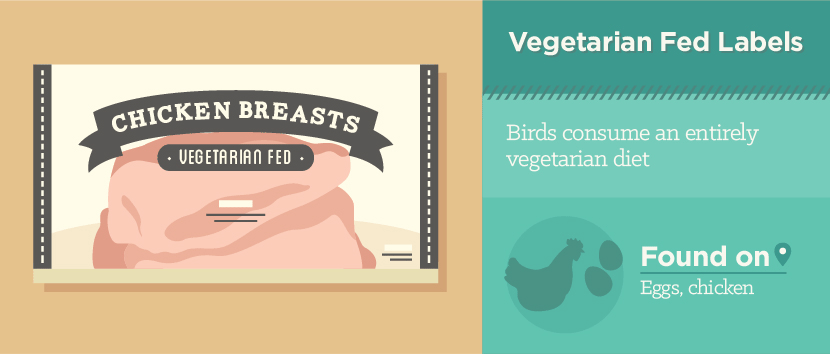
Whole Grain
Found on: Grain-based items, processed foods
Whole grain products use all parts of the grain, no matter what they are made of, including the nutritious bran and germ, rather than just the starchy endosperm like most other processed grain-based items. These items are higher in vitamins, minerals, and fiber than their conventional counterparts.http://www.thekitchn.com/multigrain-whole-grain-whole-wheat-whats-the-difference-176886
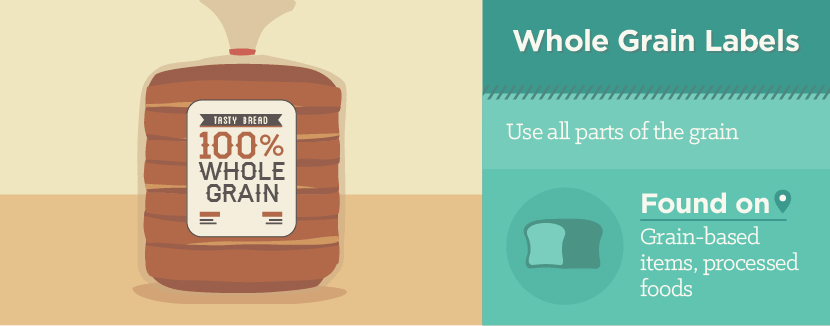
The biggest takeaway? While food labels are meant to help indicate what’s inside, they can also be pretty misleading. Don’t be tricked by flashy claims of “all natural!” and “low fat”: Take the time to understand exactly what those labels mean, what ingredients are hiding inside the packaging, and how the animals and animal products you’re purchasing were raised or produced.
Embed the article on your site

